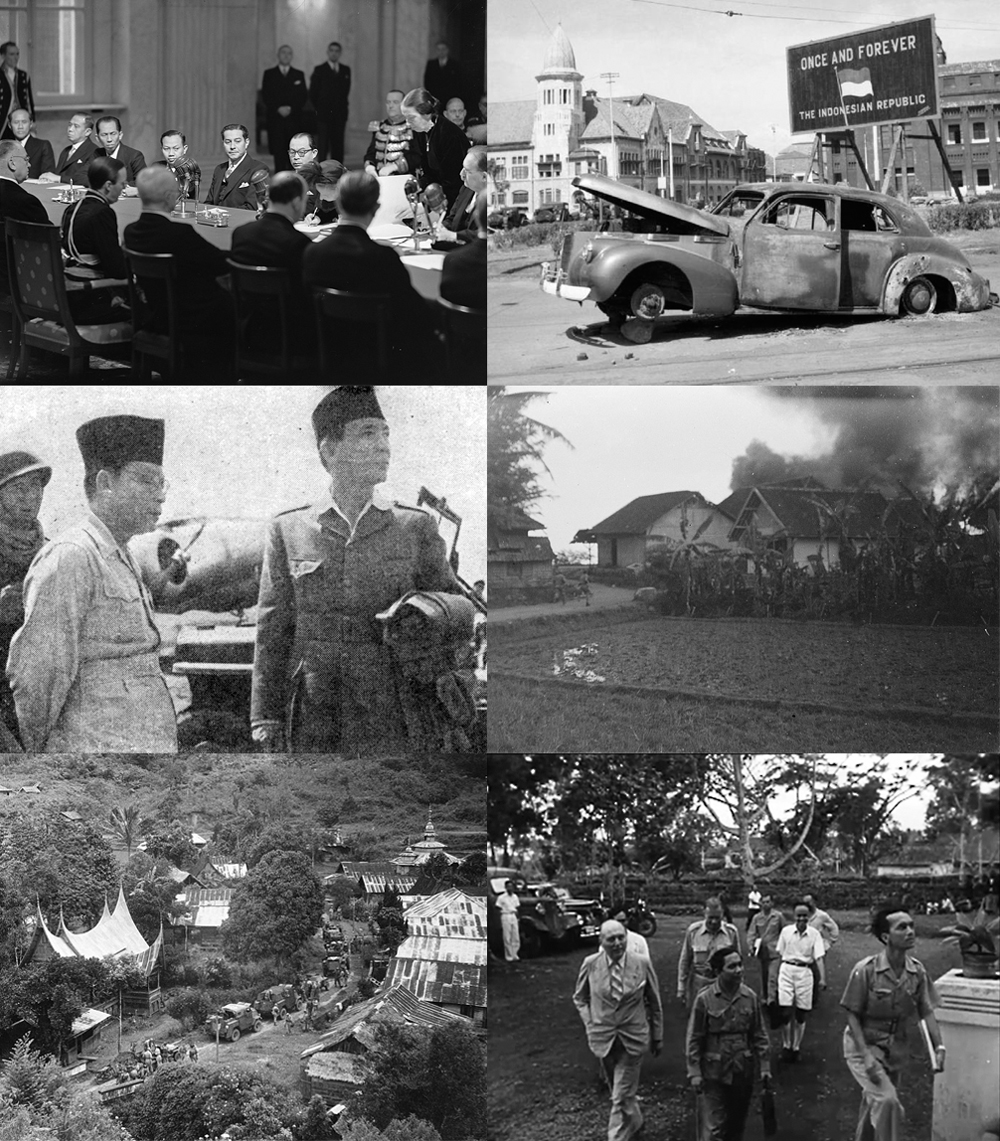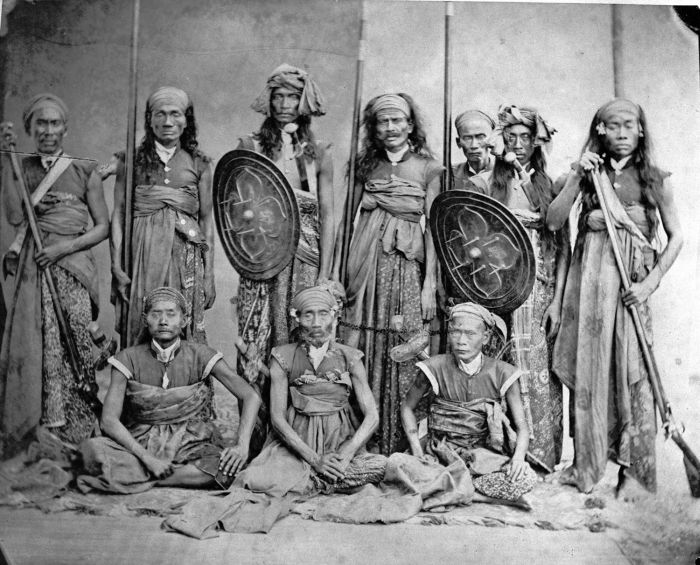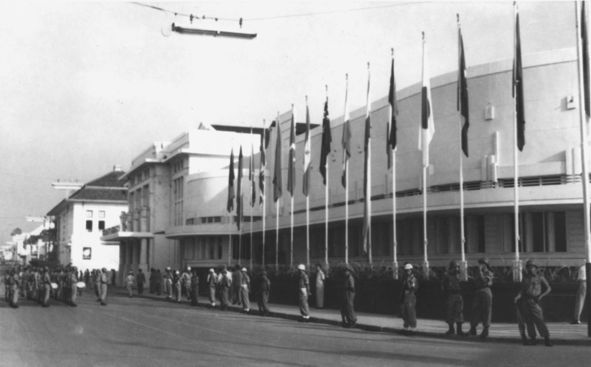|
Timeline Of The Indonesian National Revolution
This is the Timeline of Indonesian National Revolution 1945 *early 1945: Small, mostly Dutch, commando units parachute into northern Sumatra. August *15 August: The Japanese surrender brings the fighting in World War II to an official close. *17 August: "Proclamation of Indonesian Independence", signed by Sukarno- Hatta. * Tan Malaka, a former Indonesian Communist Party (PKI) leader, returns secretly from exile and reveals his identity in Jakarta and draws a large following. *late August: A Republican government is established in Jakarta and a provisional constitution is adopted. Central Indonesian National Committee (KNIP) established. *17 to 25 August: The Japanese in Java and Sumatra disband the ''PETA/Giyūgun'' and ''Heiho'', dismantling command structures and membership. *22 August: The Japanese announce their surrender publicly across Indonesia. *August to September: Euphoria of revolution spreads across the country, while local Japanese commanders and their troops ... [...More Info...] [...Related Items...] OR: [Wikipedia] [Google] [Baidu] |
Indonesian National Revolution
The Indonesian National Revolution, or the Indonesian War of Independence, was an armed conflict and diplomatic struggle between the Republic of Indonesia and the Dutch Empire and an internal social revolution during postwar and postcolonial Indonesia. It took place between Indonesia's declaration of independence in 1945 and the Netherlands' transfer of sovereignty over the Dutch East Indies to the Republic of the United States of Indonesia at the end of 1949. The four-year struggle involved sporadic but bloody armed conflict, internal Indonesian political and communal upheavals, and two major international diplomatic interventions. Dutch military forces (and, for a while, the forces of the World War II allies) were able to control the major towns, cities and industrial assets in Republican heartlands on Java and Sumatra but could not control the countryside. By 1949, international pressure on the Netherlands, the United States threatening to cut off all economic ai ... [...More Info...] [...Related Items...] OR: [Wikipedia] [Google] [Baidu] |
Heiho
were native Indonesian units raised by the Imperial Japanese Army during its occupation of the Dutch East Indies in World War II. Alongside the ''Heiho'', the Japanese organized ''Giyūgun'' (義勇軍, "Volunteer army"), such as the Java-based " Defenders of the Homeland" (PETA; id, Pembela Tanah Air, ja, 郷土防衛義勇軍, Kyōdo Bōei Giyūgun). Indonesian youths who joined the ''Heiho'' were never given high ranks or positions, contrasted by the young people who were members of PETA or other ''Giyūgun'' and often received appointments and promotions. This discrimination carried over into public life, where ''Heiho'' members had to salute any Japanese citizen, both civilians and military. In addition, there was also a difference in salary, accommodation, and food with the ''heitai'' (兵隊, "soldiers") of the ''Giyūgun'', which were adjusted according to the social status of the individual ''Heiho'' soldier. The monthly salary of a ''Heiho'' was only 30 rupiah f ... [...More Info...] [...Related Items...] OR: [Wikipedia] [Google] [Baidu] |
Padang, Indonesia
Padang () is the capital and largest city of the Indonesian province of West Sumatra. With a Census population of 1,015,000 as of 2022, it is the 16th most populous city in Indonesia and the most populous city on the west coast of Sumatra. The Padang metropolitan area is the third most populous metropolitan area in Sumatra with a population of over 1.4 million. Padang is widely known for its Minangkabau culture, cuisine, and sunset beaches. The city had historically been a trading center since the pre-colonial era, trading in pepper and gold. The Dutch made contact with the city in the mid 17th century, eventually constructing a fortress and taking over control of the city from the Pagaruyung Kingdom. Save for several interruptions of British rule, Padang remained part of the Dutch East Indies as one of its major cities until Indonesian independence. In 1906, Padang along with Palembang became the first populated places in Sumatra to achieve city status (''gemeente''). ... [...More Info...] [...Related Items...] OR: [Wikipedia] [Google] [Baidu] |
Abangan
The ''Abangan'' are Javanese people who are Muslims and practice a much more syncretic version of Islam than the more orthodox santri. The term, apparently derived from the Javanese language word for red, ''abang'', was first developed by Clifford Geertz, but the meaning has since shifted. ''Abangan'' are more inclined to follow a local system of beliefs called adat and Kebatinan than pure Sharia (Islamic law). Their belief system integrates Hinduism, Buddhism and animism. However, some scholars hold that what has classically been viewed as Indonesian variance from Islam is often a part of that faith in other countries. For example, Martin van Bruinessen notes similarity between ''adat'' and historical practice among Muslims in Egypt as described by Edward Lane. Indonesian mass killings of 1965–66 Many Abangans were supporters of the Communist Party of Indonesia (PKI), and their interests were thus supported by the PKI. They subsequently made up most of the people who w ... [...More Info...] [...Related Items...] OR: [Wikipedia] [Google] [Baidu] |
Banjarmasin
) , translit_lang1 = Other , translit_lang1_type1 = Jawi , translit_lang1_info1 = بنجر ماسين , settlement_type = City , motto = ''Kayuh Baimbai'' ( Banjarese: 'Rowing Together') , image_skyline = , image_caption = Clockwise from top: Banjarmasin seen from above, Soetji Nurani Chinese Temple, Banjarmasin watchtower, and Banjarmasin floating market. , image_flag = Flag of Banjarmasin City.png , image_shield = Lambang Kota Banjarmasin.gif , image_map = , mapsize = , map_caption = Interactive map outlining Banjarmasin , pushpin_map = Indonesia , pushpin_label_position = right , pushpin_map_caption = Location within Indonesia , subdivision_type = Country , subdivision_name = Indonesia ... [...More Info...] [...Related Items...] OR: [Wikipedia] [Google] [Baidu] |
Sulawesi
Sulawesi (), also known as Celebes (), is an island in Indonesia. One of the four Greater Sunda Islands, and the world's eleventh-largest island, it is situated east of Borneo, west of the Maluku Islands, and south of Mindanao and the Sulu Archipelago. Within Indonesia, only Sumatra, Borneo, and Papua are larger in territory, and only Java and Sumatra have larger populations. The landmass of Sulawesi includes four peninsulas: the northern Minahasa Peninsula, the East Peninsula, the South Peninsula, and the Southeast Peninsula. Three gulfs separate these peninsulas: the Gulf of Tomini between the northern Minahasa and East peninsulas, the Tolo Gulf between the East and Southeast peninsulas, and the Bone Gulf between the South and Southeast peninsulas. The Strait of Makassar runs along the western side of the island and separates the island from Borneo. Etymology The name ''Sulawesi'' possibly comes from the words ''sula'' ("island") and ''besi'' ("iron") and may ref ... [...More Info...] [...Related Items...] OR: [Wikipedia] [Google] [Baidu] |
Merdeka Square, Jakarta
Merdeka Square (Indonesian: ''Medan Merdeka'' or ''Lapangan Merdeka'', formerly nl, Koningsplein, lit. "King's Square") is a large square located in the center of Jakarta, Indonesia. '' Merdeka'' is the Indonesian word for freedom or independence. Measuring approximately one square kilometer in area, if the surrounding fields within the Merdeka Square are included, it is considered one of the largest squares in the world. At 75 hectares, it is over five times the size of Tiananmen Square, and 12 times the size of Place de la Concorde. At its center stands the National Monument, often called ''Monas'' (''Monumen Nasional''). The paved plaza surrounds the monument often host national events such as military and float parades, as well as civic demonstrations. Surrounding the Monument is now a park with a musical fountain in western side, and a deer enclosure where deer roam among the shady trees in the southeast corner. The square is a popular destination for Jakartans for sport ... [...More Info...] [...Related Items...] OR: [Wikipedia] [Google] [Baidu] |
Central Java
Central Java ( id, Jawa Tengah) is a province of Indonesia, located in the middle of the island of Java. Its administrative capital is Semarang. It is bordered by West Java in the west, the Indian Ocean and the Special Region of Yogyakarta in the south, East Java in the east, and the Java Sea in the north. It has a total area of 32,800.69 km2, with a population of 36,516,035 at the 2020 Census making it the third-most populous province in both Java and Indonesia after West Java and East Java. The official estimate as at mid 2021 was 36,742,501.Badan Pusat Statistik, Jakarta, 2022. The province also includes the island of Nusakambangan in the south (close to the border of West Java), and the Karimun Jawa Islands in the Java Sea. Central Java is also a cultural concept that includes the Yogyakarta Special Region, in turn including the city of Yogyakarta; however, administratively that city and its surrounding regencies have formed a separate special region (equiva ... [...More Info...] [...Related Items...] OR: [Wikipedia] [Google] [Baidu] |
Lombok
Lombok is an island in West Nusa Tenggara province, Indonesia. It forms part of the chain of the Lesser Sunda Islands, with the Lombok Strait separating it from Bali to the west and the Alas Strait between it and Sumbawa to the east. It is roughly circular, with a "tail" (Sekotong Peninsula) to the southwest, about across and a total area of about including smaller offshore islands. The provincial capital and largest city on the island is Mataram. Orang Lombok is some what similar in size and density, and shares some cultural heritage with the neighboring island of Bali to the west. However, it is administratively part of West Nusa Tenggara, along with the larger and more sparsely populated island of Sumbawa to the east. Lombok is surrounded by a number of smaller islands locally called Gili. The island was home to some 3,168,692 Indonesians as recorded in the decennial 2010 censusBiro Pusat Statistik, Jakarta, 2011. and 3,758,631 in the 2020 Census;Badan Pusat Stat ... [...More Info...] [...Related Items...] OR: [Wikipedia] [Google] [Baidu] |
Bali
Bali () is a province of Indonesia and the westernmost of the Lesser Sunda Islands. East of Java and west of Lombok, the province includes the island of Bali and a few smaller neighbouring islands, notably Nusa Penida, Nusa Lembongan, and Nusa Ceningan to the southeast. The provincial capital, Denpasar, is the List of Indonesian cities by population, most populous city in the Lesser Sunda Islands and the second-largest, after Makassar, in Eastern Indonesia. The upland town of Ubud in Greater Denpasar is considered Bali's cultural centre. The province is Indonesia's main tourist destination, with a significant rise in tourism since the 1980s. Tourism-related business makes up 80% of its economy. Bali is the only Hinduism in Indonesia, Hindu-majority province in Indonesia, with 86.9% of the population adhering to Balinese Hinduism. It is renowned for its highly developed arts, including traditional and modern dance, sculpture, painting, leather, metalworking, and music. The Ind ... [...More Info...] [...Related Items...] OR: [Wikipedia] [Google] [Baidu] |
Surabaya
Surabaya ( jv, ꦱꦸꦫꦧꦪ or jv, ꦯꦹꦫꦨꦪ; ; ) is the capital city of the Indonesian province of East Java and the second-largest city in Indonesia, after Jakarta. Located on the northeastern border of Java island, on the Madura Strait, it is one of the earliest port cities in Southeast Asia. According to the National Development Planning Agency, Surabaya is one of the four main central cities of Indonesia, alongside Jakarta, Medan, and Makassar. The city has a population of 2.87 million within its city limits at the 2020 census and 9.5 million in the extended Surabaya metropolitan area, making it the second-largest metropolitan area in Indonesia. The city was settled in the 10th century by the Kingdom of Janggala, one of the two Javanese kingdoms that was formed in 1045 when Airlangga abdicated his throne in favor of his two sons. In the late 15th and 16th centuries, Surabaya grew to be a duchy, a major political and military power as well ... [...More Info...] [...Related Items...] OR: [Wikipedia] [Google] [Baidu] |
Bandung
Bandung ( su, ᮘᮔ᮪ᮓᮥᮀ, Bandung, ; ) is the capital city of the Indonesian province of West Java. It has a population of 2,452,943 within its city limits according to the official estimates as at mid 2021, making it the fourth most populous city in Indonesia. Greater Bandung (Bandung Basin Metropolitan Area/BBMA) is the country's third-largest metropolitan area, with nearly nine million inhabitants. Located above sea level, the highest point in the North area with an altitude of 1,050 meters and the lowest in the South is 675 meters above sea level, approximately southeast of Jakarta, Bandung has cooler year-round temperatures than most other Indonesian cities. The city lies on a river basin surrounded by volcanic mountains that provides a natural defence system, which was the primary reason for the Dutch East Indies government's plan to move the capital from Batavia (modern-day Jakarta) to Bandung. The Dutch first established tea plantations around the moun ... [...More Info...] [...Related Items...] OR: [Wikipedia] [Google] [Baidu] |








